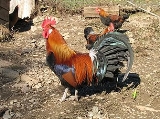
The Taill of the Cok and the Jasp
Encyclopedia
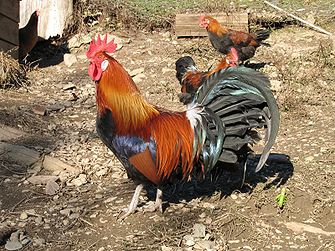
Middle Scots
Middle Scots was the Anglic language of Lowland Scotland in the period from 1450 to 1700. By the end of the 13th century its phonology, orthography, accidence, syntax and vocabulary had diverged markedly from Early Scots, which was virtually indistinguishable from early Northumbrian Middle English...
version of Aesop
Aesop
Aesop was a Greek writer credited with a number of popular fables. Older spellings of his name have included Esop and Isope. Although his existence remains uncertain and no writings by him survive, numerous tales credited to him were gathered across the centuries and in many languages in a...
's Fable
Aesop's Fables
Aesop's Fables or the Aesopica are a collection of fables credited to Aesop, a slave and story-teller believed to have lived in ancient Greece between 620 and 560 BCE. The fables remain a popular choice for moral education of children today...
The Cock and the Jewel
The Cock and the Jewel
The Cock and the Jewel is a fable attributed to Aesop. It is one of a number that feature only a single animal. As a trope in literature, the fable is reminiscent of stories used in zen such as the kōan...
by the 15th-century Scottish
Scotland
Scotland is a country that is part of the United Kingdom. Occupying the northern third of the island of Great Britain, it shares a border with England to the south and is bounded by the North Sea to the east, the Atlantic Ocean to the north and west, and the North Channel and Irish Sea to the...
poet Robert Henryson
Robert Henryson
Robert Henryson was a poet who flourished in Scotland in the period c. 1460–1500. Counted among the Scots makars, he lived in the royal burgh of Dunfermline and is a distinctive voice in the Northern Renaissance at a time when the culture was on a cusp between medieval and renaissance sensibilities...
. It is the first in Henryson's collection known as the Morall Fabillis of Esope the Phrygian. The Cok and the Jasp is framed by a prologue and a moralitas, and as the first poem in the collection it operates on a number of levels, and in all its parts, to introduce the larger cycle.
Source
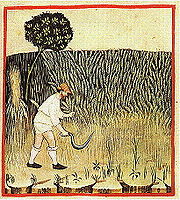
The Cock and the Jewel
The Cock and the Jewel is a fable attributed to Aesop. It is one of a number that feature only a single animal. As a trope in literature, the fable is reminiscent of stories used in zen such as the kōan...
, which Henryson re-tells, is typically simple, it is one of the most ambiguous in the fable canon. It presents what is, in effect, a riddle
Riddle
A riddle is a statement or question or phrase having a double or veiled meaning, put forth as a puzzle to be solved. Riddles are of two types: enigmas, which are problems generally expressed in metaphorical or allegorical language that require ingenuity and careful thinking for their solution, and...
on relative values with almost the force of a koan. One modern translation of the fable, in its most cogent form, runs thus:
The standard medieval interpretation of the fable, however (which Henryson follows) came down firmly against the cockerel on the grounds that the jewel represents wisdom rather than mere wealth or allure. This interpretation is expressed in the verse Romulus, the standard fable text across Europe in that era, written in the lingua franca
Lingua franca
A lingua franca is a language systematically used to make communication possible between people not sharing a mother tongue, in particular when it is a third language, distinct from both mother tongues.-Characteristics:"Lingua franca" is a functionally defined term, independent of the linguistic...
, Latin.
Henryson tacitly acknowledges this "source" in his own expanded version by claiming to be making a "translatioun" from the Latin and directly quoting some of its lines. The Romulus was a standard classroom text used in primary education to teach Latin. Since The Cock and the Jewel (De Gallo et Jaspide
The Cock and the Jewel
The Cock and the Jewel is a fable attributed to Aesop. It is one of a number that feature only a single animal. As a trope in literature, the fable is reminiscent of stories used in zen such as the kōan...
) was the first fable in this standard collection, it was, de facto, a universally familiar text in literary consciousness throughout Europe.
Prologue
There is little doubt that the succinct prolog which leads into the Cok and the Jasp is intended to introduce a general collection of Fabillis, not solely the Fabill of the Cok and the Jasp. It opens with a defense of poetryArs Poetica
Ars Poetica is a term meaning "The Art of Poetry" or "On the Nature of Poetry". Early examples of Ars Poetica by Aristotle and Horace have survived and have since spawned many other poems that bear the same name...
(expanded from the verse Romulus), presents an apologia for making the translatioun
Translation
Translation is the communication of the meaning of a source-language text by means of an equivalent target-language text. Whereas interpreting undoubtedly antedates writing, translation began only after the appearance of written literature; there exist partial translations of the Sumerian Epic of...
, establishes the first person
First-person narrative
First-person point of view is a narrative mode where a story is narrated by one character at a time, speaking for and about themselves. First-person narrative may be singular, plural or multiple as well as being an authoritative, reliable or deceptive "voice" and represents point of view in the...
narrator
Narrator
A narrator is, within any story , the fictional or non-fictional, personal or impersonal entity who tells the story to the audience. When the narrator is also a character within the story, he or she is sometimes known as the viewpoint character. The narrator is one of three entities responsible for...
, summarises Aesop's work and provides a bridging passage into the First Fabill.
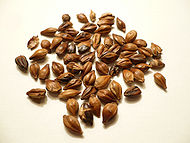
Fiction
Fiction is the form of any narrative or informative work that deals, in part or in whole, with information or events that are not factual, but rather, imaginary—that is, invented by the author. Although fiction describes a major branch of literary work, it may also refer to theatrical,...
, even though it may be feinyeit
Deception
Deception, beguilement, deceit, bluff, mystification, bad faith, and subterfuge are acts to propagate beliefs that are not true, or not the whole truth . Deception can involve dissimulation, propaganda, and sleight of hand. It can employ distraction, camouflage or concealment...
by nature, can have a sound moral purpose at heart, and that stories which are pleisand
Aesthetics
Aesthetics is a branch of philosophy dealing with the nature of beauty, art, and taste, and with the creation and appreciation of beauty. It is more scientifically defined as the study of sensory or sensori-emotional values, sometimes called judgments of sentiment and taste...
(line 4) or merie
Humour
Humour or humor is the tendency of particular cognitive experiences to provoke laughter and provide amusement...
(line 20) are better suited to convey wisdom than dry scholastic
Scholasticism
Scholasticism is a method of critical thought which dominated teaching by the academics of medieval universities in Europe from about 1100–1500, and a program of employing that method in articulating and defending orthodoxy in an increasingly pluralistic context...
writing. Henryson develops his meaning using three images; cereal cultivation
Cereal
Cereals are grasses cultivated for the edible components of their grain , composed of the endosperm, germ, and bran...
(stanza 2), the nuttis schell
Nutshell
A nutshell is the outer shell of a nut. Most nutshells are inedible and are removed before eating the nut meat inside.-Usage:Most nutshells are useful to some extent, depending on the circumstances...
(stanza 3) and the bowstring (stanza 4).
In stanza 5 (the middle stanza of the prolog) the narrator identifies and directly addresses his audience for the first time as my maisteris
Medieval university
Medieval university is an institution of higher learning which was established during High Middle Ages period and is a corporation.The first institutions generally considered to be universities were established in Italy, France, and England in the late 11th and the 12th centuries for the study of...
, or in other words, his own university educated
Academic degree
An academic degree is a position and title within a college or university that is usually awarded in recognition of the recipient having either satisfactorily completed a prescribed course of study or having conducted a scholarly endeavour deemed worthy of his or her admission to the degree...
peers. The writer, in effect, is figuring himself in the role of student before his teachers (his readers). The stanza also makes cryptic reference to an unnamed commissioning patron
Patrón
Patrón is a luxury brand of tequila produced in Mexico and sold in hand-blown, individually numbered bottles.Made entirely from Blue Agave "piñas" , Patrón comes in five varieties: Silver, Añejo, Reposado, Gran Patrón Platinum and Gran Patrón Burdeos. Patrón also sells a tequila-coffee blend known...
for the poem who may or may not have existed.
The humility topos
Recusatio
A recusatio is a poem in which the poet claims he is supposedly unable or disinclined to write the type of poem which he originally intended to, and instead writes in a different style....
continues into the next stanza where the narrator pretends to have no understanding of eloquence
Eloquence
Eloquence is fluent, forcible, elegant or persuasive speaking. It is primarily the power of expressing strong emotions in striking and appropriate language, thereby producing conviction or persuasion...
and an ability only to write in rude
Plain language
Plain language is clear, succinct writing designed to ensure the reader understands as quickly and completely as possible.Plain language strives to be easy to read, understand, and use. It avoids verbose, convoluted language and jargon...
and hamelie
Vernacular
A vernacular is the native language or native dialect of a specific population, as opposed to a language of wider communication that is not native to the population, such as a national language or lingua franca.- Etymology :The term is not a recent one...
language, a self-deferential reference to his choice to create poetry in Scots
Middle Scots
Middle Scots was the Anglic language of Lowland Scotland in the period from 1450 to 1700. By the end of the 13th century its phonology, orthography, accidence, syntax and vocabulary had diverged markedly from Early Scots, which was virtually indistinguishable from early Northumbrian Middle English...
rather than Latin
Medieval Latin
Medieval Latin was the form of Latin used in the Middle Ages, primarily as a medium of scholarly exchange and as the liturgical language of the medieval Roman Catholic Church, but also as a language of science, literature, law, and administration. Despite the clerical origin of many of its authors,...
. He concludes by inviting his readers to correct any mistakes they may find.
A brief precis
Précis
A précis is a type of summary or abridgment.Précis or Precis may also refer to:*Mitsubishi Precis, another name for the Hyundai Excel*Précis , debut album by Michigan-based musician Benoit Pioulard...
of Aesop's fable literature then follows in the next three stanzas with a stark view of its purposes and some comments on how animal behaviour
Animal behaviour
Animal behaviour is the subject of:* The field of Ethology* Animal Behaviour, a scientific journal...
and human nature
Human nature
Human nature refers to the distinguishing characteristics, including ways of thinking, feeling and acting, that humans tend to have naturally....
compare. The ninth stanza ends with a swift bridging passage into the first Fabill.
Fable
.jpg)
Gemstone
A gemstone or gem is a piece of mineral, which, in cut and polished form, is used to make jewelry or other adornments...
and sets the location for its discovery as a midden
Landfill
A landfill site , is a site for the disposal of waste materials by burial and is the oldest form of waste treatment...
. He also expands the cockerel's arguments and ultimate reasons for the rejection of the jasp as a carefully orchestrated passage of fully fleshed oration which nonetheless continues to sound as if it is being delivered in the voice of a cockerel. But since this is not so much a story — more a strongly drawn vignette
Vignette (literature)
In theatrical script writing, sketch stories, and poetry, a vignette is a short impressionistic scene that focuses on one moment or gives a trenchant impression about a character, an idea, or a setting and sometimes an object...
— the fabill does not yet fully live up to the requirements for fully effective storytelling argued for in the prolog. This will come in the subsequent fabillis, and so, in a sense, the First Fabill partly acts to defer reader's expectations.
The cok addresses the stone directly, acknowledges its worth, recognises it has been misplaced and argues, realistically enough, that to him it is of no practical use. The jasp, he says, is an object that belongs more properly to a lord
Lord
Lord is a title with various meanings. It can denote a prince or a feudal superior . The title today is mostly used in connection with the peerage of the United Kingdom or its predecessor countries, although some users of the title do not themselves hold peerages, and use it 'by courtesy'...
or king
Monarchy
A monarchy is a form of government in which the office of head of state is usually held until death or abdication and is often hereditary and includes a royal house. In some cases, the monarch is elected...
(line 81), while he is content simply to satisfy his humble wants in draf
Chaff
Chaff is the dry, scaly protective casings of the seeds of cereal grain, or similar fine, dry, scaly plant material such as scaly parts of flowers, or finely chopped straw...
, corn
Maize
Maize known in many English-speaking countries as corn or mielie/mealie, is a grain domesticated by indigenous peoples in Mesoamerica in prehistoric times. The leafy stalk produces ears which contain seeds called kernels. Though technically a grain, maize kernels are used in cooking as a vegetable...
, worm
Worm
The term worm refers to an obsolete taxon used by Carolus Linnaeus and Jean-Baptiste Lamarck for all non-arthropod invertebrate animals, and stems from the Old English word wyrm. Currently it is used to describe many different distantly-related animals that typically have a long cylindrical...
is and snail
Snail
Snail is a common name applied to most of the members of the molluscan class Gastropoda that have coiled shells in the adult stage. When the word is used in its most general sense, it includes sea snails, land snails and freshwater snails. The word snail without any qualifier is however more often...
lis — his daily meit
Bread
Bread is a staple food prepared by cooking a dough of flour and water and often additional ingredients. Doughs are usually baked, but in some cuisines breads are steamed , fried , or baked on an unoiled frying pan . It may be leavened or unleavened...
. The rhetorical climax comes in the seventh stanza of the fabill in which the cok, rising on a number of rhetorical question
Rhetorical question
A rhetorical question is a figure of speech in the form of a question posed for its persuasive effect without the expectation of a reply. Rhetorical questions encourage the listener to think about what the answer to the question must be. When a speaker states, "How much longer must our people...
s, finishes with an almost fantastical exortation for the stone to levitate and transport itself back to some more royal place:
- Quhar suld thow mak thy habitatioun?
- Quhar suld thow duell bot in ane royall tour?
- Quhar suld thow sit bot on ane kingis crounHonours of ScotlandThe Honours of Scotland, also known as the Scottish regalia and the Scottish Crown Jewels, dating from the fifteenth and sixteenth centuries, are the oldest set of crown jewels in the British Isles. The existing set were used for the coronation of Scottish monarchs from 1543 to 1651...
, - Exaltit in worschip and in grit honour?
- Rise gentill jasp, of all stanisRock (geology)In geology, rock or stone is a naturally occurring solid aggregate of minerals and/or mineraloids.The Earth's outer solid layer, the lithosphere, is made of rock. In general rocks are of three types, namely, igneous, sedimentary, and metamorphic...
the flourFlowerA flower, sometimes known as a bloom or blossom, is the reproductive structure found in flowering plants . The biological function of a flower is to effect reproduction, usually by providing a mechanism for the union of sperm with eggs... - Out of this midding, and pas quhar thow suld be;
- Thow ganis not for me, nor I for the.
(M.F. lines 106-112)
And the cock, leaving the jasp, exits the poem to seek his meit (line 114).
Moralitas
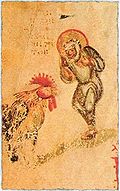
Moral
A moral is a message conveyed or a lesson to be learned from a story or event. The moral may be left to the hearer, reader or viewer to determine for themselves, or may be explicitly encapsulated in a maxim...
itas. This was a common device in medieval and renaissance fable literature, and its use here establishes the convention that Henryson will employ consistently through all thirteen of the Morall Fabillis.
In this case, however, before the Moralitas properly begins, stanza 18 (the ninth stanza of the fabill) as a footnote to the taill, intercedes with a compressed account of the qualities of the jasp, including its protective properties
Magic (paranormal)
Magic is the claimed art of manipulating aspects of reality either by supernatural means or through knowledge of occult laws unknown to science. It is in contrast to science, in that science does not accept anything not subject to either direct or indirect observation, and subject to logical...
, which almost instantly casts doubt on the wisdom of the cock's decision. For example, lines 125-6:
- Quha hes this stane sall have gude hapLuckLuck or fortuity is good fortune which occurs beyond one's control, without regard to one's will, intention, or desired result. There are at least two senses people usually mean when they use the term, the prescriptive sense and the descriptive sense...
to speidProsperProsper may refer to:In people:* Prosper de Mestre Sydney businessman fom 1818 to 1844* Prosper of Aquitaine, also known as Prosper Tiro, Christian writer and disciple of St Augustine* Prosper of Catenanuova, martyr, patron saint of Catenanuova...
, - Of fyre nor water him neidis not to dreidFearFear is a distressing negative sensation induced by a perceived threat. It is a basic survival mechanism occurring in response to a specific stimulus, such as pain or the threat of danger...
.
In a sense, stanza 18 presents a new riddle and, to be answered, requires the cock's argument to be turned.
The Moralitas proper is usually given to begin after stanza 18 in most textual witnesses except Bannatyne
George Bannatyne
George Bannatyne , collector of Scottish poems that were very dramatic and emotional, was a native of Newtyle, Angus. He became an Edinburgh merchant and was admitted a burgess in 1587. Some years earlier, in 1568, when the "pest" raged in the capital, he retired to his native county and amused...
. Its five stanzas come down explicitly against the cock and so, by implication, present a conceit
Conceit
In literature, a conceit is an extended metaphor with a complex logic that governs a poetic passage or entire poem. By juxtaposing, usurping and manipulating images and ideas in surprising ways, a conceit invites the reader into a more sophisticated understanding of an object of comparison...
of closure
Deductive closure
Peter D. Klein, in the second edition of The Cambridge Dictionary of Philosophy, defines closure as follows:A set of objects, O, is said to exhibit closure or to be closed under a given operation, R, provided that for every object, x, if x is a member of O and x is R-related to any object, y, then...
on Aesop's more open and enigmatic original. The narrator minces no words in expressing how serious the cockerel's error has been in rejecting the stone because, he says, the jasp represents science
Science in the Middle Ages
Science in the Middle Ages consisted of the study of nature, including practical disciplines, the mathematics and natural philosophy in medieval Europe. Following the fall of the Western Roman Empire and the decline in knowledge of Greek, Christian Western Europe was cut off from an important...
, in the sense of wisdom
Wisdom
Wisdom is a deep understanding and realization of people, things, events or situations, resulting in the ability to apply perceptions, judgements and actions in keeping with this understanding. It often requires control of one's emotional reactions so that universal principles, reason and...
, which he defines in terms that bring it close in meaning to concepts like dharma
Dharma
Dharma means Law or Natural Law and is a concept of central importance in Indian philosophy and religion. In the context of Hinduism, it refers to one's personal obligations, calling and duties, and a Hindu's dharma is affected by the person's age, caste, class, occupation, and gender...
. In the final stanza he laments mankind's general failure to respect and comprehend these values:
- Bot now, allace, this jasp is tyntLossLoss may refer to:*A negative difference between retail price and cost of production**Loss leader a deliberate commercial loss made in the expectation of recouping it by profitable sales of other lines...
and hid; - We seik it nocht, nor preis it for to find…
He closes, with pretended indifference, by advising the reader, if he so wishes, to go seek the jasp where it lies.
Themes
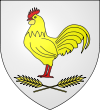
Loading (disambiguation)
Loading is the insertion of impedance into a circuit to change the characteristics of the circuit.Loading may also refer to:* Carbohydrate loading, a strategy employed by endurance athletes to maximize the storage of glycogen in the muscles...
is extremely rich.
Even though the moralitas comes down sincerely and emphatically on the side of the rejected stone, nevertheless, the cockerel has raised questions that are not necessarily easily resolved. The subsequent poems will appear to further intensify many of those doubt
Doubt
Doubt, a status between belief and disbelief, involves uncertainty or distrust or lack of sureness of an alleged fact, an action, a motive, or a decision. Doubt brings into question some notion of a perceived "reality", and may involve delaying or rejecting relevant action out of concerns for...
s and dichotomies rather than resolving them. Therefore the riddling aspect to the Aesop
Aesop
Aesop was a Greek writer credited with a number of popular fables. Older spellings of his name have included Esop and Isope. Although his existence remains uncertain and no writings by him survive, numerous tales credited to him were gathered across the centuries and in many languages in a...
ian original is, in some regards, not ultimately overturned and is arguably maintined as part of the fabric of the poem.
Among the specific issues touched on or implied in Henryson's expansion are questions of fiction
Fiction
Fiction is the form of any narrative or informative work that deals, in part or in whole, with information or events that are not factual, but rather, imaginary—that is, invented by the author. Although fiction describes a major branch of literary work, it may also refer to theatrical,...
and truth
Truth
Truth has a variety of meanings, such as the state of being in accord with fact or reality. It can also mean having fidelity to an original or to a standard or ideal. In a common usage, it also means constancy or sincerity in action or character...
, appetite
Appetite
The appetite is the desire to eat food, felt as hunger. Appetite exists in all higher life-forms, and serves to regulate adequate energy intake to maintain metabolic needs. It is regulated by a close interplay between the digestive tract, adipose tissue and the brain. Decreased desire to eat is...
, self-interest, fecklessness
Moral responsibility
Moral responsibility usually refers to the idea that a person has moral obligations in certain situations. Disobeying moral obligations, then, becomes grounds for justified punishment. Deciding what justifies punishment, if anything, is a principle concern of ethics.People who have moral...
, materialism
Materialism
In philosophy, the theory of materialism holds that the only thing that exists is matter; that all things are composed of material and all phenomena are the result of material interactions. In other words, matter is the only substance...
, duty
Duty
Duty is a term that conveys a sense of moral commitment to someone or something. The moral commitment is the sort that results in action and it is not a matter of passive feeling or mere recognition...
, wisdom
Wisdom
Wisdom is a deep understanding and realization of people, things, events or situations, resulting in the ability to apply perceptions, judgements and actions in keeping with this understanding. It often requires control of one's emotional reactions so that universal principles, reason and...
, hierarchy
Hierarchy
A hierarchy is an arrangement of items in which the items are represented as being "above," "below," or "at the same level as" one another...
, equality
Social equality
Social equality is a social state of affairs in which all people within a specific society or isolated group have the same status in a certain respect. At the very least, social equality includes equal rights under the law, such as security, voting rights, freedom of speech and assembly, and the...
, education
Education
Education in its broadest, general sense is the means through which the aims and habits of a group of people lives on from one generation to the next. Generally, it occurs through any experience that has a formative effect on the way one thinks, feels, or acts...
, social order
Social order
Social order is a concept used in sociology, history and other social sciences. It refers to a set of linked social structures, social institutions and social practices which conserve, maintain and enforce "normal" ways of relating and behaving....
, government
Government
Government refers to the legislators, administrators, and arbitrators in the administrative bureaucracy who control a state at a given time, and to the system of government by which they are organized...
, the nature of aristocracy
Aristocracy
Aristocracy , is a form of government in which a few elite citizens rule. The term derives from the Greek aristokratia, meaning "rule of the best". In origin in Ancient Greece, it was conceived of as rule by the best qualified citizens, and contrasted with monarchy...
, the nature of royalty
Royal family
A royal family is the extended family of a king or queen regnant. The term imperial family appropriately describes the extended family of an emperor or empress, while the terms "ducal family", "grand ducal family" or "princely family" are more appropriate to describe the relatives of a reigning...
and many others. There is also the question of who the cockerel ultimately represents and whether, in some sense, Henryson's poem itself is ultimately the jasp
Jasper
Jasper, a form of chalcedony, is an opaque, impure variety of silica, usually red, yellow, brown or green in color; and rarely blue. This mineral breaks with a smooth surface, and is used for ornamentation or as a gemstone. It can be highly polished and is used for vases, seals, and at one time for...
which the reader has encountered "in the midden" to take or leave as he or she wishes.
Opening lines
It is worth noting that the opening of Henryson's Prolog to the Morall Fabillis echoes the opening lines of John Barbour's Brus. It is therefore a variation on the theme of the relation between truth and report in literature. For comparison, the first ten lines, of The BrusThe Brus
The Brus is a long narrative poem of just under 14,000 octosyllabic lines composed by John Barbour which gives a historic and chivalric account of the actions of Robert the Bruce and the Black Douglas in the Scottish Wars of Independence during a period from the circumstances leading up the English...
, composed in the 1370s, run:
- Storyss to redeReading (process)Reading is a complex cognitive process of decoding symbols for the intention of constructing or deriving meaning . It is a means of language acquisition, of communication, and of sharing information and ideas...
ar delitibill - Suppos that thai be nocht but fabill,
- Than suld storys that suthfast wer
- And thai war said on gud maner
- Have doubill plesance in heryng.
- the first plesance is the carpyngRecitationA recitation is a presentation made by a student to demonstrate knowledge of a subject or to provide instruction to others. In some academic institutions the term is used for a presentation by a teaching assistant or instructor, under the guidance of a senior faculty member, that supplements...
, - And the tother the suthfastnes
- That shawys the thing rycht as it wes,
- And suth thyngis that ar likand
- Till mannys heryng ar plesand.
(Barbour, The Brus, lines 1-10)
Henryson's first stanza, written just over a century later, uses a number of the same (or similar) terms, but, in shorter space, generates a slightly less sanguine impression of the relation between narrative, audience and subject. The differences are subtle, but distinct:
- Thocht feinyit fabillis of ald poetreClassicsClassics is the branch of the Humanities comprising the languages, literature, philosophy, history, art, archaeology and other culture of the ancient Mediterranean world ; especially Ancient Greece and Ancient Rome during Classical Antiquity Classics (sometimes encompassing Classical Studies or...
- Be not al grunded upon truth, yit than
- Thair polite termes of sweit rhetore
- Richt plesand ar unto the eir of man;
- And als the caus that thay first began
- Wes to repreifCritiqueCritique is a method of disciplined, systematic analysis of a written or oral discourse. Critique is commonly understood as fault finding and negative judgement, but it can also involve merit recognition, and in the philosophical tradition it also means a methodical practice of doubt...
the haill misleving - Off man be figureRepresentation (arts)Representation is the use of signs that stand in for and take the place of something else. It is through representation that people organize the world and reality through the act of naming its elements...
of ane uther thing.
(Henryson, Morall Fabillis, lines 1-7)
Numbers
The first fabill, in all its three parts, occupies 23 stanzas, distributed 9—9—5.- Prolog: 9 stanzas
- Fabill: 9 stanzas, including stanza 18 on the properties of the jasp (see above).
- Moralitas: 5 stanzas
Because of the ambiguity of the status of stanza 18 (as in a sense a second "mini" moralitas) the count could be interpreted as
- 9—8—6,
or even perhaps,
- 9—8—1—5.

